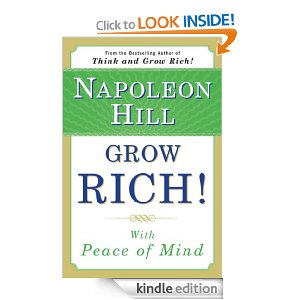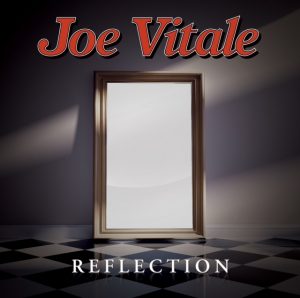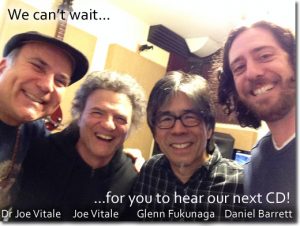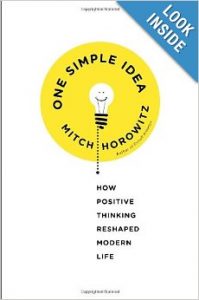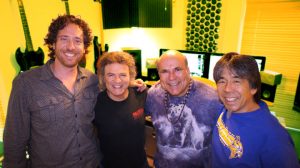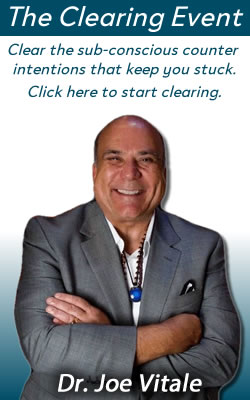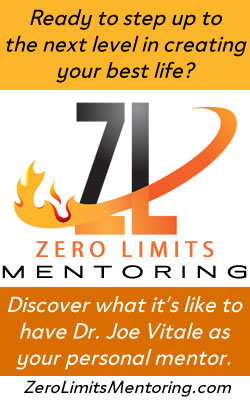Tag: joe vitale
Napoleon Hill's Final Secret
When I look around my office, I see success literature everywhere.
One of my favorites, especially in my early years, was Napoleon Hill’s classic, Think and Grow Rich.
You know that one. But I wonder if you know about another, smaller book he wrote 40 years later, when he was nearly 85 years old, called Grow Rich with Peace of Mind.
He said he wrote it because he wanted to demonstrate more fully not only that “there is more to life than making money” but also “that peace of mind in itself is a mighty force in helping you make money.”
He’s right on both counts.
But here’s something else he wrote – something intriguing you might easily overlook:
“I have said this book has been nearly 70 years in the planning. Quite true, but until recently I did not know it. I believe we are all guided by invisible sources of inspiration, and recently there came to me inspiration from a strange and very real source, revealing how much of my life has been spent in preparing me to write these pages, urging me to uncover my typewriter and get to work.”
Just reading that gives me chills — especially in light of my newest audio program with Nightingale-Conant – The Zero Point: How to Enter the Realm of Limitless Possibilities.
What is this invisible source of inspiration that Napoleon Hill describes?
The Zero Point.
The White Board.
Source.
Divinity.
Witness.
All that is.
Zero is not something “out there.”
It’s something within you, intrinsic and innate, that whispers to your heart, “Be this…Do this…”
It includes your mind, but goes beyond your mind.
It’s how you can think bigger than ever before.
Zero is alive – and you can make a request of it that is so magnificent that you’re constantly able to live a life of consistent expectancy.
This is not the same as intending something.
Intentions are from your ego, based on your past.
They’re based on what your mind thinks is possible, which means that intentions are based on current data.
They have built-in limitations.
Inspiration, on the other hand, can blow your mind.
How do you receive this kind of inspiration?
As I wrote in my recently released book, At Zero: The Quest for Miracles through Ho’oponopono —
“The key to modern day Ho’oponopono is letting go of any and all programs, so you can be one with Divinity, otherwise called at Zero. The secret is to delete the programming as you become aware of it. When you do, Divinity will come to you and through you.”
I believe when Napoleon Hill talked about peace of mind and inspiration, he was referring to the Zero Point. I believe he was quite familiar with it.
How else could he have written a book that reached around the world as many times as Think and Grow Rich?
Just as I said in my new audio program, the promise of Zero, of awakening to your Divinity, is such that it will “help you create limitless possibilities for yourself, your family, your friends, and the world at large – from this day forward, a new level of peace, joy, and confidence.”
Napoleon Hill – he was my kind of guy.
Inspiration was his secret, too.
Ao Akua
Joe
PS – Research shows you can change a habit in 30 days but you need help to do so. Here’s a new way to do just that when it comes to attracting more money My Wake Up Calls.
Mindless Sax
During the recent recording of my seventh album, titled Reflection, I mentioned the term “unconscious competence” to my band.
It refers to a mental state where you can perform without thinking; your body and mind automatically know what to do without concentration.
Since the term was new to the folks I was sharing it with, I thought it might be new to you, as well.
According to Wikipedia, the four stages of competence is a model of learning. It was created by Noel Burch in the 1970s for Gordon Training International. The four stages are —
- Unconscious incompetence – You can’t do something and aren’t aware that you can’t.
- Conscious incompetence – You can’t do something and are aware that you can’t.
- Conscious competence – You can do something but only with concentration.
- Unconscious Competence – You can do something without thought.
It’s useful to remember these steps when trying to do anything new.
For example, when you first learned how to drive a car, you were in the second stage: you can’t drive and you know you can’t. As you took lessons, you moved into the third stage.
Today, you probably drive your car without thinking about it. You are now an unconscious competent driver. That’s why you can drive and talk, listen to music, and even make a phone call. It’s second nature to you.
Driving is now automatic.
The problem in doing something new is wanting to be a master – unconsciously competent – when you don’t yet have the skills.
An example might be tossing you the keys to a huge tractor-trailer truck with 18 gears and telling you to drive it.
Good luck.
I’ve driven such rigs, and the eighteen gears are confusing.
I could urge you on, inspire you and motivate you, but if you have no practice with shifting eighteen gears, you won’t be able to do it.
No amount of pep talks will get you moving that rig.
No amount of saying “Trust your body” or “Your mind knows” or “You can do it!” will get you moving that tracker-trailer in a safe, reliable way.
Why?
You don’t yet have the skills to do so.
When I’m in the studio recording new music, I can’t jump to “unconsciously competent” in some areas yet because I haven’t learned the skills or put in the hours to make it as easy as breathing.
I have to slow down, focus, stay aware, and consciously become competent.
In time, I will move into unconscious competence as a performer.
Here’s another example:
Drummer Joe Vitale – the Rock and Roll Hall of Fame legend who plays with Joe Walsh, Neil Young and other icons – told me he can play the drums in his sleep. He is unconsciously competent in that area.
But he is not quite so certain on the keyboards.
There, he is a consciously competent performer.
He can do it but, as he told me, it takes concentration.
When we were recording, someone mentioned a baritone saxophone.
A what?
We called up the band Morphine, which leans on a bari sax to create its haunting sound, and listened.
I was instantly in love with the gutsy, sexy music.
I then looked at baritone saxes online.
Talk about intimidating.
Put one in my hands and I wouldn’t know how to hold it, let alone play it.
Of course, given enough time, lessons, and focused practice, I’d learn my way around that instrument.
So here’s how the four stages of learning look in this case:
- Unconscious incompetence – I never even heard of a baritone sax.
- Conscious incompetence – I know what it is but know I can’t play it.
- Conscious competence – If I took lessons and practiced, I could play it with focused awareness.
- Unconscious Competence – Given enough practice, I could pick it up and play it without thinking.
What did I do next?
I knew I loved the sound of the bari sax, so I found an Austin player and hired him. He came to the studio and added sultry spice to one of my songs. While I had his ear, I asked all kinds of questions about the sax and how to buy one, play one, etc.
I then contacted the sax instructor he told me was the best one.
I then ordered the book he told me to get: The Devil’s Horn.
And I then went online and researched vintage baritone saxophones, as I knew I wanted an investment grade instrument.
Do you see how this works?
I went from being oblivious about the bari sax (unconscious incompetence) to the second stage (conscious incompetence) and now moving into stage three (conscious competence). As long as I maintain lessons and practice, I can — given enough time — move into the fourth stage: Unconscious Competence, or “Mindless Sax.” (Couldn’t help myself). 🙂
But I couldn’t just pick up the sax and play!
All of this is a reminder to be easy with yourself.
As you learn any new skill, you need to relax, focus, absorb and keep practicing.
You can master virtually any skill, but it takes time, awareness, intent and discipline.
Just under three years ago, I couldn’t sing, play guitar, write songs or music, or record anything.
Today I have seven albums.
Seven!
The payoff of patience and practice is great success.
And you’re worth it.
Ao Akua,
joe
PS – My albums are described at these sites:
http://www.GetUpandStrut.com
http://www.HealingMojoMusic.com
http://www.AligningtoZero.info (a bestseller)
http://www.TheHealingSong.com
http://www.HealingRockMusic.com
http://www.AtZeroMusic.com (NEW)
Note: Album number seven is called Reflection. I’ll let you know when it’s available. 🙂
Law of Attraction Secret
According to Mitch Horowitz, in his new book, One Simple Idea: How Positive Thinking Reshaped Modern Life, the phrase “Law of Attraction” was first used in 1855 by a trance medium named Andrew Jackson Davis.
A trance medium?
That was news to me.
I have an entire library of vintage New Thought, metaphysical, and spiritual books, yet never heard of Davis.
Apparently Davis went into trances and dictated metaphysical messages. His medium side channeled a large body of work, including a six-volume set of spiritual laws called, The Great Harmonia.
In volume four, Davis used the term “Law of Attraction.” But Davis meant the law to refer to the kinds of spirits you attracted to yourself after you died and went to the other side. His term had nothing to do with the cause-and-effect law we think of today.
It was in 1892 that the law as we know it began to take shape.
Prentice Mulford, an early New Thought author, mentioned it in his famous book, Your Forces, And How to Use Them.
In 1897, Ralph Waldo Trine used the term in his classic book, In Tune with the Infinite.
And Helen Wilmans used the term in her 1899 book, Conquest of Poverty.
But the biggest push in getting “Law of Attraction” into mainstream thinking came in 1902, when William Walker Atkinson devoted an entire chapter to the subject in his book, The Law of the New Thought.
As you can see, the term has been around a long time.
Of course, the core LOA (Law of Attraction) concept of “your thoughts create reality” goes all the way back to Buddha, Jesus, and ancient cultures.
Only the phrase “Law of Attraction” is relatively new – at least from 1855, if Mitch Horowitz’s research is accurate (and I believe it is.)
All of this reading and research caused me to go back and re-read some of my favorite LOA authors, to be reminded of their stories and secrets.
One of them is Brown Landone, a prolific author who lived almost 100 years and wrote such gems as The Success Process and How to Turn Your Desires and Ideals into Realities.
In my 1927 copy of The Success Process, Landone uses chapter three to explain “The ‘Doing Process’ Which Always Succeeds.”
I smiled to see how much focus he put on taking action, one of the most overlooked steps in many modern Law of Attraction groupies.
But Landone spelled out that the kind of action you need to take is what he called “idealized doing.”
For him, you began with “vivid imagining.”
That meant using all your senses to experience the end result of what you wanted to attract.
But the next step was to envision the process of getting there.
While you may not know all the steps needed to attract or achieve a specific intention, the more you could use your senses to see the ideal action to take, the easier it would be to guarantee success.
Landone wrote –
“Your ideal of the end you desire to attain is the ‘star’ to which you should hitch your wagon of attainment. But, very much depends upon the way in which you do the hitching. Idealized doing always succeed.”
I love the fact that Law of Attraction has gone mainstream, thanks to movies and books like The Secret, and my own books such as The Attractor Factor, but I’m often dismayed that people have a superficial understanding of it.
For example, too many LOA practicioners think all they have to do is sit and visualize and what they want will “just appear.”
Well, it might just appear.
The car might appear in your driveway.
The love of your life might ring your doorbell.
But more often than not, you have to help the process along with inspired action.
Go to a car dealership.
Visit a matching service.
Do something.
Another example of an LOA fallacy is believing you get what you consciously think.
In reality, you attract what you unconsciously believe.
In other words, you can consciously believe, visualize and affirm all you want, but if you unconsciously believe something different, you won’t get your intention.
I’ve said it many times —
An unconscious counter-intention will always veto a conscious intention.
You can affirm “Money is coming to me” all day but if you unconsciously believe “Money is bad,” then you will not attract more money, or if you do, you will get rid of it fast.
Your unconscious is far more powerful than your conscious. You have to work with it to clearly and quickly manifest the results you prefer.
These points are just minor examples of the depth behind the Law of Attraction that most people aren’t at all aware of yet.
What can you do to understand LOA and use it correctly?
In my opinion, nothing is more powerful than having your own Miracles Coach.
Meanwhile, if you’ve tried to harness the Law of Attraction’s power in your own life to attract money (or anything else) and feel you’ve “failed,” then you need to see this all-new video from me http://428155.vitalesecrets.com?subid=missinglink
Expect Miracles.
Ao Akua,
Joe
PS — Some say the brief video you’ll see at this link is the most eye-opening they’ve EVER seen. Others say they just love the vest I’m wearing. http://428155.vitalesecrets.com?subid=missinglink What do you think?
Where's the Book?
Talk about emotion.
The long awaited sequel to my book Zero Limits is out and boy is it pushing people’s buttons.
At Zero became a bestseller the first week of January and is now in the hands of lots of people.
Just like with the first book, At Zero is triggering anger in some people and awakening in others.
But as I explain in the new book, what you experience is due to your own belief filters, not to the book itself.
For example —
One person says, “There’s nothing new in the book and it’s not real ho’oponopono at all.”
Yet another person reads the very same book (!) and declares, “Great new insights, advanced clearing methods, and a revelation about authentic ho’oponopono. Loved it!”
Here’s another —
One person says, “He just sells in this book.”
Yet another person reads the exact same book (!) and says, “He doesn’t sell at all in this one.”
And another —
“Joe tells stories of his struggles but doesn’t show how the practice of ho’oponopono helped him get out of them.”
Yet another person reading the very same book (!) says, “Joe shares incredible stories of his own tough times and reveals how his practice caused the problems to disappear like miracles.”
Another says —
“Joe puts down Dr. Hew Len”
Yet another person reads the exact same book (!) and says, “Joe compares Dr. Hew Len to Jesus.”
Gee, which is true?
Again, it’s not the book, but the person reading it.
You bring your own mindset to the pages.
Just like in real life. 🙂
I could show you all the expert praise for At Zero, such as —
“Joe’s new book was just as I knew it would be – FABULOUS!
The riveting stories and enlightening insights lifted my
spirits and filled my soul with love. This is indeed a path
to miracles!”
– Janet Bray Attwood, co/author NY Times bestseller,
The Passion Test
And —
“This book ought to be a movie. A masterpiece of story
telling and a revelation on how the Hawaiian healing
system of Ho’oponopono really works.”
~ Barnet Bain, movie producer, “What Dreams May Come”
and “The Celestine Prophecy”
And —
“In ‘At Zero’, Dr. Joe Vitale shares the catalyst of his
own awakening. He is vulnerable, insightful and shares
authentic Ho’oponopono secrets that are empowering and
inspiring. If you want to get to the state of zero, where
there are no limiting beliefs, I highly suggest you read
this book.”
– Dr. Steve G. Jones, Clinical Hypnotherapist
And –
“With ‘Zero Limits’, Joe Vitale introduced the world to
the incredible healing system of Ho’oponopono. Now he’s
taking it all to the next level, going deeper and revealing
the real essence and magic behind these ancient secrets.
A must read!”
– Nick Ortner, NY Times Best-Selling Author of
The Tapping Solution
— but As E.M. Forster once wrote –
“A book is a mirror; if an ass peers into it, you can’t expect an apostle to peer out.”
I think E.M. Forster was a tad harsh, but his quote points to a truth that is in the very book people are reading:
You see what you are.
In At Zero, I explain that the book isn’t even real.
It is in fact a projection created from your mental programs.
What you see in the book is in you, not in the book.
This insight is at the very heart of ho’oponopono and my new book.
It’s the fact that you (and I) have programs (beliefs), and those programs need cleaned up in order to see any mutually agreed upon reality.
The best thing to do is find out for yourself why At Zero is so powerful.
If you want to see what all the fuss is about, and if you dare to face your own beliefs, then go see –
Get the book today and get a lot of freebies.
See the site for details.
Expect Miracles.
Ao Akua,
PS — Yes, At Zero is available as a hardcover, Kindle ebook, and/or audio book, as well. All are being offered via Amazon. Go see – http://www.atzerobook.com
Free App
You can now get an app with my original music — including the songs I wrote and recorded that were nominated for the Posi Award (the Grammy’s of Positive Music) — that works on either iTunes or Android — and is yours FREE, over at — http://www.reverbnation.com/joevitale/app
It includes photos, videos, and the very popular songs —
- “Got a problem?” (The ho’oponopono song)
- “Today’s the Day!” (The wake up and do it song)
- “The Healing Song” (A hypnotic ode you’ll love)
It also includes my favorite songs —
- “Ghost Train” (Truly haunting)
- “Everybody’s Goin Thru Somethin” (My core message)
- “Sperichil” (Toe-tapping fun)
And the songs were recorded with true legends of music, including rock ‘n roll Hall of Fame drummer Joe Vitale (yes, he has the same name as mine), bass player Glenn Fukunaga, and producer/guitar slinger Daniel Barrett. A few songs have guest appearances by Guitar Monk Mathew Dixon. Grammy winners helped mix and master much of the music.
All in all, it’s pretty a-maz-ing.
My singer-songwriter albums are on iTunes, and CD Baby, but the app has almost all of my songs on it — and it includes videos, photos, and more.
Again, the app is free.
Go get it at — http://www.reverbnation.com/joevitale/app
Enjoy!
Ao Akua,
joe
PS — If you prefer the actual CDs, the sites for all of them (with audio samples) are —
http://www.GetUpandStrut.com
http://www.HealingMojoMusic.com
http://www.AligningtoZero.info (a bestseller)
http://www.TheHealingSong.com
http://www.HealingRockMusic.com
http://www.AtZeroMusic.com (NEW)
Note: I’m currently recording my SEVENTH album!

